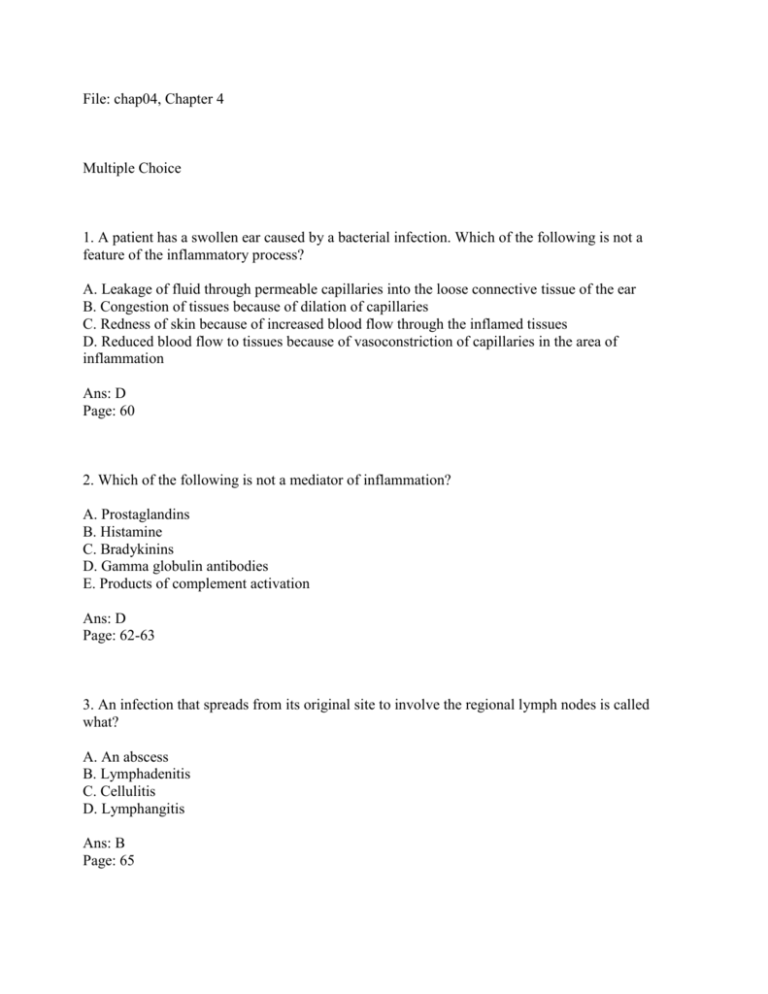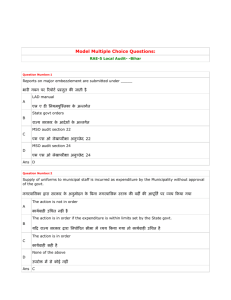chap04, Chapter 4 - Test Bank Doctor
advertisement

File: chap04, Chapter 4 Multiple Choice 1. A patient has a swollen ear caused by a bacterial infection. Which of the following is not a feature of the inflammatory process? A. Leakage of fluid through permeable capillaries into the loose connective tissue of the ear B. Congestion of tissues because of dilation of capillaries C. Redness of skin because of increased blood flow through the inflamed tissues D. Reduced blood flow to tissues because of vasoconstriction of capillaries in the area of inflammation Ans: D Page: 60 2. Which of the following is not a mediator of inflammation? A. Prostaglandins B. Histamine C. Bradykinins D. Gamma globulin antibodies E. Products of complement activation Ans: D Page: 62-63 3. An infection that spreads from its original site to involve the regional lymph nodes is called what? A. An abscess B. Lymphadenitis C. Cellulitis D. Lymphangitis Ans: B Page: 65 4. What is the antibody-producing cell that plays an important role in protecting us from infection? A. Plasma cell B. T lymphocyte C. Monocyte D. Neutrophil Ans: A Page: 66, cross-reference in Chapter 5, page 77 5. Which of the following statements about pathogenic microorganisms is NOT true? A. The ability to cause disease depends on the virulence of the organism and the integrity of the body’s immune defenses. B. Adrenal corticosteroids facilitate destruction of organisms and promote recovery. C. They usually incite an inflammatory response at the site of invasion. D. The ability to respond to a pathogen is in part genetically determined. Ans: B Page: 63 6. A young man is struck on the cheek by a baseball and sustains an injury in which the skin is not broken and the cheekbone is not fractured. He develops an acute inflammation in the injured area. Which of the following is NOT part of the acute inflammatory process? A. Leakage of fluid through permeable capillaries into the connective tissue of the cheek B. Congestion of tissues caused by dilation of capillaries C. Accumulation of leukocytes in the injured area D. Accumulation of plasma cells and formation of immunoglobulins Ans: D Page: 60 7. The most important cell in the acute inflammatory response is an actively phagocytic cell called the __________. A. mononuclear cell B. monocyte C. polymorphonuclear leukocyte D. macrophage Ans: C Page: 60 8. Which of the following are systemic effects from an inflammatory response? A. Elevated temperature B. Redness and swelling C. Blisters D. Pus Ans: A Page: 60 9. These are chemical agents that are released when tissue is damaged, promoting an inflammatory response. A. Exudate B. Mediators of inflammation C. Mononuclear cells D. Vasodilators Ans: B Page: 62-63 10. Cells that most commonly active during chronic infections are: A. lymphocytes, monocytes, and plasma cells. B. polymorphonuclear leukocytes, monocytes, and mast cells. C. complement and bradykinins. D. None of the above. Ans: A Page: 66 11. What does the ending –itis indicate when it is affixed to the name of an organ or tissue (e.g., hepatitis)? A. Pain is present in that tissue or organ. B. An infection or an inflammatory process is occurring in that tissue or organ. C. The tissue or organ has sustained serious and irreversible damage. D. An abscess is present in the tissue or organ. Ans: B Page: 64-65 12. Injury and infection by a pathogenic organism can cause inflammation. What else can cause an inflammatory response? A. Administration of corticosteroid hormones B. Excess lysosomes in the cells C. Interaction of antibodies and antigens D. No other causes exist Ans: C Page: 64 13. What happens when the vasodilator histamine is released by the mast cells? A. The inflammatory process is ended. B. Blood platelets adhere to collagen fragments and begin the healing process. C. Blood vessels expand and become more permeable. D. Blood vessels constrict and become less permeable. Ans: C Page: 62 14. The term virulence refers to __________. A. a disease caused by a viral pathogen B. a disease likely to be fatal to its host C. an organism that causes disease in humans D. the ease with which a pathogenic organism can overcome host defenses Ans: D Page: 65 True/False 15. Interaction of antigen and antibody activates a series of blood proteins called complement, and products of complement activation function as mediators of inflammation. Ans: True Page: 63 16. Extensive destruction of tissue resulting from inflammation is often followed by scarring that may impair the function of the tissue in which the scarring has occurred. Ans: True Page: 62 17. Monocytes and macrophages rush to the area of cell injury at the beginning of an acute inflammation, but are not active in chronic inflammation. Ans: False Page: 60 18. The inflammatory reaction is the same no matter what kind of injury is present, because the injury itself does not directly cause the reaction. Ans: True Page: 19. The ability of the body’s defenses to fight off a pathogenic organism depends on both the virulence of the organisms and the resistance of the infected person. Ans: True Page: 65 20. A pathogenic organism with low virulence does not produce disease in humans. Ans: False Page: 65 21. Resolution occurs when an inflammation is mild and the tissue returns to normal without any need for repair. Ans: True Page: 62 22. Complement is activated only by the antigen–antibody interaction. Ans: False Page: 63 23. Mediators of inflammation are biologically active compounds present in the cells or blood plasma. Ans: False Page: 62 24. The release of mediators from any source can trigger not only inflammation, but also the release of other mediators. Ans: True Page: 62-63 25. Inflammation always subsides when the harmful agent that caused it is eliminated. Ans: False Page: 62 26. All inflammation results in scar formation. Ans: False Page: 62 27. A serous exudate contains a high concentration of protein. Ans: False Page: 60 Matching 28. Match the terms below with the correct definition ___ Serous exudate ___ Purulent exudate ___ Fibrinous exudates ___ Pus ___ Hemorrhagic exudate A. An exudate composed largely of inflammatory cells B. An exudate composed of fluid containing little protein C. An exudate containing red blood cells, indicating the rupture of capillaries due to inflammation D. An exudate rich in the blood protein fibrinogen E. A yellowish exudate composed of inflammatory cells Ans: B, A, D, E, C Page: 60-62 29. Match the disease name to the correct description. ___ Appendicitis ___ Pneumonitis ___ Septicemia ___ Cellulitis ___ Lymphangitis ___ Colitis A. Inflammation of the colon B. Inflammation of the lung C. An acute spreading infection at any site D. Inflammation of the appendix E. An infection that spreads into the lymphatic channels F. An infection that spreads into the bloodstream Ans: D, B, F, C, E, A Page: 64-65 Short Answer 30. What are the sources of chemical mediators of inflammation? Ans: Mast cells and blood plasma Page: 62-64 31. What is the role of lysosomal enzymes in the inflammatory process? Ans: Lysosomes contain potent enzymes that allow them to digest bacteria or foreign matter brought into cell cytoplasm by phagocytosis. Destruction of neutrophils and monocytes during the inflammatory reaction can cause lysosomal enzymes to be released and create additional tissue injury, which in turn generates further inflammatory response. Page: 63-64 32. What are bradykinins? What triggers the formation of bradykinins? Ans: Bradykinins are blood plasma mediators that form in the presence of a protein concerned with blood coagulation that is activated by tissue injury. Page: 63 33. How are adhesions formed? Ans: Fibrinous exudates involving two adjacent surfaces may cause those surfaces to stick together, eventually forming a band of fibrous tissue that is the basis of the adhesion. Page: 61 34. Name three cell-derived mediators of inflammation. Ans: Mast cells, prostaglandins, leukotrienes Page: 62-63 35. Name the four characteristic signs of localized inflammation. Ans: Heat, redness, swelling, pain Page: 60 36. Name five outcomes of inflammation. Ans: Resolution, repair, areas of destruction replaced by scar tissue, mediators intensify inflammatory process, mediators generate more mediators Page: 61-62, 64 37. What is the difference between the terms “infection” and “inflammation”? Ans: “Infection” refers to an invasion of tissues by an organism; “inflammation” refers to a bodily response to either infection or injury or an antibody–antigen interaction. Page: 59, 64 Fill in the blanks 38. __________ is a nonspecific response to an injurious agent. Ans: Inflammation Page: 59 39. __________ is an exudate made up of fibrinogen Ans: Fibrinous exudate Page: 61 40. __________ are bands of fibrous tissue that bind adjacent tissues together. Ans: Adhesions Page: 61 41: The ability of an organism to cause disease is known as __________. Ans: virulence Page: 65 42. The inflammation of lymph vessels that drain the site of an infection is called __________. Ans: lymphangitis Page: 65 Essay 43. Compare and contrast lymphangitis versus lymphadenitis Ans: Lymphangitis: inflammation of lymph vessels draining the site of an infection Lymphadenitis: inflammation of lymph nodes draining the site of an infection Page: 65 44. Compare and contrast acute versus chronic inflammation Ans: Acute inflammation is characterized by the proliferation of polymorphonuclear cells. Monocytes, macrophages, lymphocytes, and plasma cells predominate in chronic inflammation, which is a relatively quiet and smoldering process characterized by the body’s attempt to heal itself. Page: 60, 66 45. Give two examples of cell mediators of inflammation and their actions. Ans: Mast cells have granules that contain histamine, which acts as a vasodilator, increasing vascular permeability. Blood platelets contain histamine and serotonin that are released when platelets adhere to collagen fibers. Prostaglandins are derived from fatty acids and sustain inflammatory response. Leukotrienes are synthesized from arachidonic acid and increase bronchial constriction, attract neutrophils, and increase vascular permeability. Page: 63 46. Give two examples of mediators from blood plasma and their actions. Ans: Bradykinin is a vasodilator. Complement is activated by antigen-antibody reaction, leading to cell destruction. Page: 63 47. Describe the process of inflammation. Ans: attraction of leukocytes to site of injury and adhesion to endothelial lining of small blood vessels; capillary dilatation; increased capillary permeability; leakage of plasma from dilated and permeable vessels, resulting in swelling and irritation of sensory nerve endings Page: 60 48. Describe the process of scar formation. Ans: fibrous tissue that replaces normal tissue following large areas of tissue injury and damage Page: 62 49. Explain why resolution of severe inflammation may result in compromise of organ function Ans: The body’s natural response is the formation of scar tissue that replaces normal tissue following large areas of tissue injury and damage. Fibrous connective tissue that makes up scar tissue is paler, thicker than surrounding tissue, with limited function. Page: 62 50. Explain why inflammation can become chronic. Ans: Chronic inflammation represents a stalemate or balance between the body’s attempt to heal itself in the presence of continuing inflammation. Page: 66







